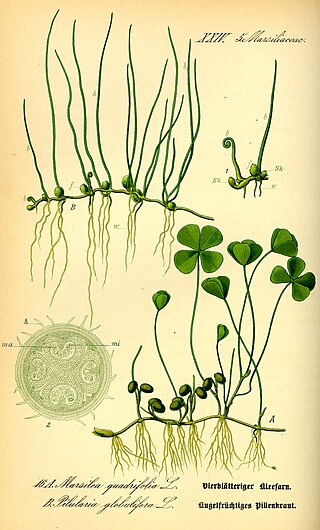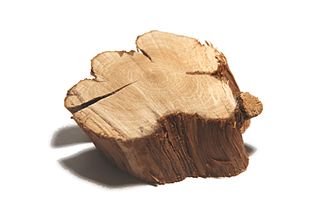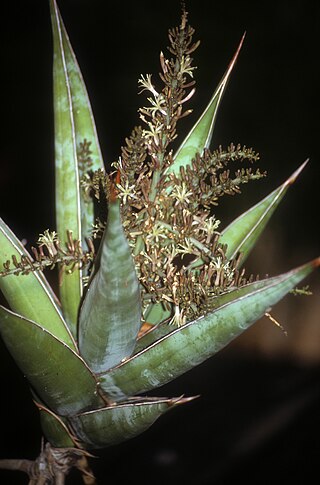Description
Lindernia intrepida grows in intertwined mats, with two different leaves. One is an underwater awl-shaped leaf that is 1 to 2 cm (0.39 to 0.79 in) long. Two pairs of unequal length leaves float on the water, 5 to 7 mm (0.20 to 0.28 in) and oval-shaped. The plant grows from a small 1 mm (0.039 in) rhizome growing in a combination of sand, organic debris, leaf remains, and animal dung that is 1 cm (0.39 in) deep. The flowers have two lips, and are white or pale pink with purple speckles. [2]
Lindernia intrepida is one of approximately 330 desiccant-tolerant vascular plants, 90% of which are found growing on inselbergs. It is one of the rare desiccant-tolerant vascular plants that is not a fern or monocotyledon. The basal leaves can survive complete drying for 4.5 months, with more than 50% of them reviving after receiving moisture—so the plants simply resume growing once the pools fill again after a dry spell. New floating leaves, which do not survive drying as well as the basal leaves, can reach the water surface as soon as 2–4 days after the pool refills, with flowers appearing as early as 4 days after breaking dormancy. [2]

Herbaceous plants are vascular plants that have no persistent woody stems above ground. This broad category of plants includes many perennials, and nearly all annuals and biennials.

Marsileaceae is a small family of heterosporous aquatic and semi-aquatic ferns, though at first sight they do not physically resemble other ferns. The group is commonly known as the "pepperwort family" or as the "water-clover family" because the leaves of the genus Marsilea superficially resemble the leaves of a four-leaf clover. In all, the family contains 3 genera and 50 to 80 species with most of those belonging to Marsilea.

Nelumbo nucifera, also known as sacred lotus, Indian lotus, or simply lotus, is one of two extant species of aquatic plant in the family Nelumbonaceae. It is sometimes colloquially called a water lily, though this more often refers to members of the family Nymphaeaceae.

Pleopeltis polypodioides, also known as the resurrection fern, is a species of creeping, coarse-textured fern native to the Americas and Africa.
Mesophytes are terrestrial plants which are adapted to neither particularly dry nor particularly wet environments. An example of a mesophytic habitat would be a rural temperate meadow, which might contain goldenrod, clover, oxeye daisy, and Rosa multiflora. Mesophytes prefer soil and air of moderate humidity and avoid soil with standing water or containing a great abundance of salts. They make up the largest ecological group of terrestrial plants, and usually grow under moderate to hot and humid climatic regions.
Pachypodiumhabitats consist of isolated, specialized, micro–environmental niches, generally xeric, rocky, frost-free areas within parts of western Madagascar and southern Africa. Pachypodium species are often indifferent to the regional ecological, biotic zone of vegetation, a fact which explains some of Pachypodium morphology and architecture. The large scale vegetation zones are in some cases irrelevant to the micro-environments of Pachypodium, in the sense that the xeric niches may be embedded in larger mesic biomes.

Aponogeton distachyos or Aponogeton distachyum, also known as waterblommetjie, Cape-pondweed, water hawthorn, vleikos and Cape pond weed is an aquatic flowering plant.

Selaginella lepidophylla, also known as a resurrection plant, is a species of desert plant in the spikemoss family (Selaginellaceae). It is native to the Chihuahuan Desert of the United States and Mexico. S. lepidophylla is renowned for its ability to survive almost complete desiccation. Resurrection plants are vascular rooted plants capable of surviving extreme desiccation, then resuming normal metabolic activity upon rehydration. The plant's hydro-responsive movements are governed by stem moisture content, tissue properties and a graded distribution of lignified cells affecting concentric stem stiffness and spiraling. During dry weather in its native habitat, its stems curl into a tight ball, uncurling only when exposed to moisture.

Oxalis triangularis, commonly called false shamrock, is a species of perennial plant in the family Oxalidaceae. It is native to several countries in southern South America. This woodsorrel is typically grown as a houseplant but can be grown outside in USDA climate zones 8a–11, preferably in light shade.
A xerophile is an extremophilic organism that can grow and reproduce in conditions with a low availability of water, also known as water activity.

A woody plant is a plant that produces wood as its structural tissue and thus has a hard stem. In cold climates, woody plants further survive winter or dry season above ground, as opposed to herbaceous plants that die back to the ground until spring.
A xerophyte is a species of plant that has adaptations to survive in an environment with little liquid water. Examples of xerophytes include cacti, pineapple and some gymnosperm plants. The morphology and physiology of xerophytes are adapted to conserve water during dry periods. Some species called resurrection plants can survive long periods of extreme dryness or desiccation of their tissues, during which their metabolic activity may effectively shut down. Plants with such morphological and physiological adaptations are said to be xeromorphic. Xerophytes such as cacti are capable of withstanding extended periods of dry conditions as they have deep-spreading roots and capacity to store water. Their waxy, thorny leaves prevent loss of moisture.
Desiccation tolerance refers to the ability of an organism to withstand or endure extreme dryness, or drought-like conditions. Plants and animals living in arid or periodically arid environments such as temporary streams or ponds may face the challenge of desiccation, therefore physiological or behavioral adaptations to withstand these periods are necessary to ensure survival. In particular, insects occupy a wide range of ecologically diverse niches and, so, exhibit a variety of strategies to avoid desiccation.

Dracaena pinguicula, synonym Sansevieria pinguicula, also known as the walking sansevieria, is a xerophytic CAM succulent native to the Bura area of Kenya, near Garissa. The species was described by Peter René Oscar Bally in 1943.

Iris fulva, also known as copper iris, is a species in the genus Iris, it is also in the subgenus Limniris and in the series Hexagonae. It is a rhizomatous perennial, endemic to the southern and central United States. It has copper-red to deep red flowers and bright green leaves.

Iris hexagona, commonly known as the Dixie iris, is a species in the genus Iris, it is also in the subgenus Limniris and in the series hexagonae. It is a rhizomatous perennial with long bright green leaves, long thin stem and has small groups of flowers in shades of blue, from violet, to bluish purple, to lavender. It flowers in springtime and is native to the southeastern and south-central US states.

Iris typhifolia is a species in the genus Iris, also the subgenus Limniris and in the series Sibiricae. It is a rhizomatous herbaceous perennial, from China. It has slender, twisted leaves, deep green slender hollow stem and 2 violet-blue flowers. It is cultivated as an ornamental plant in temperate regions.

Iris wilsonii is a species of flowering plant in the family Iridaceae, native to China. It is placed in the series Sibiricae of the subgenus Limniris of the genus Iris. This rhizomatous herbaceous perennial has long and drooping grey-green leaves, hollow stems and two fragrant yellow, pale yellow or yellow/white flowers.

Craterostigma plantagineum, is a resurrection plant species in the genus Craterostigma. It is a dwarf growing plant and can be found to make a 'carpet' across the ground, with blooms in shades of blue and purple. It is a well-studied desiccation-tolerant species known for its extreme vegetative tolerance against dehydration and desiccation. It is native to parts of Africa and to India. It is known as a resurrection plant.

Moss lawns are lawns composed of moss, which occur naturally, but can also be cultivated like grass lawns. They are a defining element in moss gardens.















